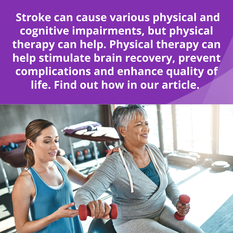 Stroke is a serious medical condition that occurs when the blood supply to a part of the brain is interrupted, causing brain cells to die. Stroke can cause a variety of symptoms like weakness, paralysis, speech difficulties, memory loss, cognitive problems and emotional changes. Physical therapy is an important part of recovery from a stroke that aims to help stroke survivors regain their functional mobility and independence. PT helps stroke survivors stimulate damaged nerves and muscles, promote circulation to affected areas of the brain to promote healing, learn to move and use their affected body parts as much as possible, regain mobility and strength, as well as to prevent or reduce complications such as muscle stiffness, spasticity, pain and falls. Physical Therapy After Stroke Physical therapy usually begins as soon as possible after the stroke, ideally within two days. The duration and intensity of PT depend on the severity and type of stroke, the medical status of the patient, as well as the individual's goals and needs. Stroke recovery doesn’t just involve a physical therapist, though. It takes a team of professionals, including a physiatrist (a doctor who specializes in rehabilitation), a neurologist (a doctor who specializes in brain and nervous system disorders), nurses, an occupational therapist, a speech-language pathologist, a dietician, a social worker, a neuropsychologist and a case manager. The physical therapist will assess strength, balance, coordination, range of motion, sensation, pain and functional abilities. Based on the assessment and the individual's goals, the physical therapist will design a personalized treatment plan that may include interventions like:
The Benefits of Physical Therapy After Stroke Physical therapy has lots of benefits for stroke survivors, such as:
Physical therapy after stroke can also have positive effects on the brain itself. Research has shown that physical activity can stimulate the growth of new brain cells, formation of new connections between brain cells and growth of new blood vessels in the brain. These processes can help with healing and recovery after stroke. Physical therapy after stroke is not a one-size-fits-all approach. It requires individualized assessment, planning and evaluation. It also requires active participation and collaboration from the stroke survivor, their family and their caregivers. Stroke recover is a long-term process that requires patience, perseverance and dedication. However, physical therapy can be rewarding and empowering for stroke survivors. It can help them regain their functional mobility and independence, improve their quality of life and well-being, prevent or reduce complications and make the most of their recovery. References
0 Comments
Leave a Reply. |
Archives
March 2024
Categories |
|
Central phone: 262-796-2850
Central fax: 262-796-2851 Central email: patientcare@ptplus.com Website by RyTech, LLC
|
|
